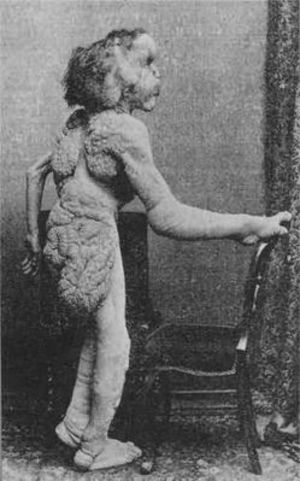The recent, sudden death of Anna Nicole Smith shocked everyone, and has kept Hollywood gossip hot for weeks. However, as we approach the beginning of April, we need to take a look back. We need to look back on the life of a man who was treated like an object, exploited for the entertainment of an abusive, jeering public. His name was Joseph Carey Merrick, and I would like to share a few details of his tortured existence.
On August 5, 1862, a bouncing baby boy was born to Joseph and Mary Jane Merrick, and he was raised at various dwellings throughout Leicester, England. As a working class family, they were far from wealthy, a situation exacerbated by an absentee father. By the age of two, Joseph began exhibiting signs of a troubling disease. His sister died of bronchopneumonia when he was eleven, and went to live with his father and stepmother later that year, after the death of his mother.
By now Joseph is more than just a troubled lad who had lost half his family to illness and disease. He had also been diagnosed with neurofiromatosis, which explained the symptoms he was presenting. However, that theory has since been disproved, and we now know that he actually had Proteus syndrome. Named for the Greek god Proteus, (a sea god, capable of assuming various shapes) because of the variable manifestation of the disease. Most patients experience enlarged skulls, hands, and feet, and subcutaneous tumors that develop and grow quickly.
Joseph’s father and stepmother found such a child to be an embarrassment, and he was forced to sell things in the streets to earn his keep. On these sales excursions, Joseph was followed and taunted mercilessly for the growths that had formed over his body and face. In addition to these, he had difficulty walking, a useless right arm, and a head so large that it was difficult to move. Eventually, Joseph’s stepmother grew tired of caring for him and gave his father an ultimatum; it was her or the boy. He chose her, and in 1879 Joseph left home forever, heading to the Leicester Union Workhouse.
Always willing to earn his keep, Joseph gave one hundred percent to any job he could get. However his disability made him mostly unemployable, despite having the ability to read and write. Educated at the System Street Board School, Joseph was not only literate, (a difficult feat with his poor background) but an eloquent speaker as well. These talents did little for him though, and in 1884 he began working as a sideshow freak.
His manager, Tom Norman, took excellent care of Joseph contrary to the portrayal in David Lynch’s film, “The Elephant Man”. It made sense for Norman to look after Joseph not only in a humane way, but a kind and caring way as well. After all, Joseph was his paycheck. As cruel as it was, Joseph Carey Merrick was soon coined “The Elephant Man” because of tusk like growth on his face, and because of his thickened skin hanging from him in swaying folds. This title caught on like wildfire, and soon a promoter was selling the show with a crazy story about The Elephant Man’s mother being trampled by an elephant while pregnant. Legend had it that Joseph looked the way he did as a result of that collision.
Eventually Joseph moved from Leicester to London to continue working in the show. Here he meant Frederick Treves, who held a great interest in Joseph’s condition. Treves befriended Joseph in order to find out more about the condition and his life, and after consideration Joseph allowed Treves to present his case to two different medical societies. This encounter would forever alter Joseph’s life.
In 1885, these type of shows became illegal in Britain, so Joseph moved across the channel to Belgium, where he began seeking similar employment. This didn’t last long though, soon after an 1886 encounter with an Austrian showman, the man stole his savings and threw him out into the street. Losing the last of his hope, Joseph made his way back to England where he was found by police, starving and destitute, crumpled into a heap on the floor of the Liverpool Street Station, taunted not just by children this time, but adults as well.
After finding the business card of Frederick Treves in Joseph’s coat pocket, police took him to the London Hospital to be placed into his care. Hospitals in those days couldn’t accommodate the special needs of long term care patients, although this was just what Joseph required. Here he could not only be under the care of a single physician, but could have the permanent home that he had been seeking since he was a boy.
This was eventually arranged, in the East Wing of the London Hospital, paid for with charitable public donations received when Treves would give presentations about Joseph’s condition. The East Wing was where Joseph would spend the rest of his life, enjoying care and real acceptance for the first time. Unable to leave the hospital grounds, the world was becoming a more lonely and dangerous place for Joseph.
In 1888, Jack the Ripper was terrorizing the streets of East London, near the hospital where Joseph was housed. Aware of his deformities and appearance, many locals assumed that he was the serial killer destroying their families. Had Joseph left the hospital, he would have probably been lynched based on that fact alone.
Joseph was allowed to accept guests though, and was said to be a most gracious host. During this time, his caregivers began noticing a decline in his speech and other abilities, a sure sign that his condition was oworsening. Using his one able hand, Joseph built a model of a church sent to him from a German correspondent, and it was during this period that he became aware that the hospital wasn’t going to be home forever.
Once Joseph became aware that he wouldn’t be able to stay at the hospital, he made a request of his friend, Frederick Treves. He asked Treves to move him to a home for the blind when the time came. Why? So the other residents couldn’t stare at him. This request went unfulfilled though, soon after that conversation, Joseph was found dead, on his back, with no signs of a struggle.
Often complaining to his caregivers about how he wished he could sleep normally, Joseph may have just given up, deciding that he was going to go to sleep like everyone else, even if that meant he was never going to wake up. While there are no writtem historical accounts of suicide, Joseph knew how to deal with his cumbersome head, and shouldn’t have had any problems.
After he died on April 11, 1890, it was determined that his death was probably caused by the weight of his head falling backward, which dislocated his neck. Lying on his back to sleep literally killed this man, as he usually had to sleep with his knees drawn up close to his chest with his head resting there, instead of on a pillow. The next time you can’t sleep because your spouse is snoring, and your pillow is lumpy, remember Joseph Carey Merrick.



